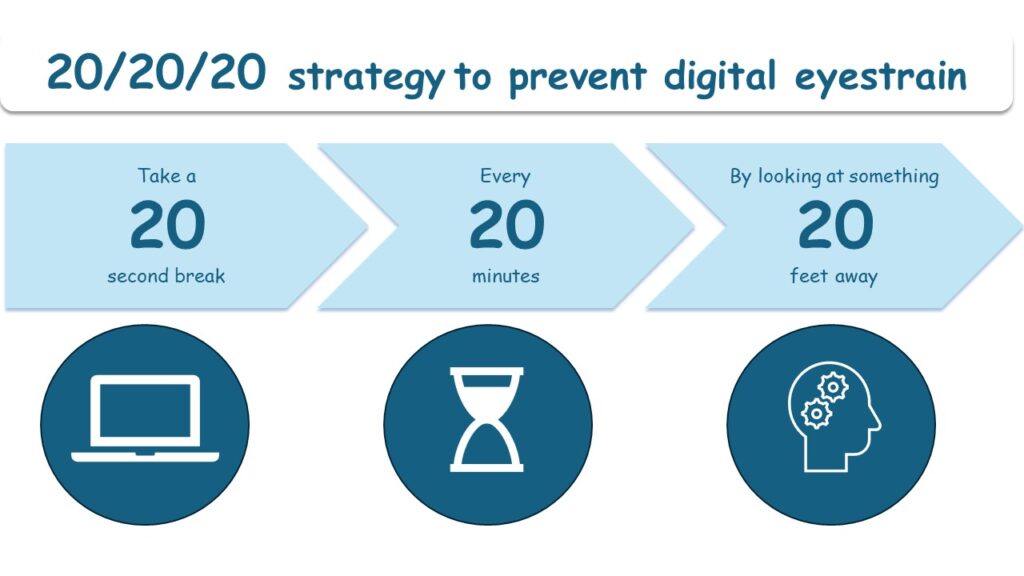In today’s digital age, we are constantly exposed to screens—whether it’s a computer at work, a smartphone on the go, or a television for leisure. Humans have reached a point, where it is an abuse of our eyes. This prolonged screen time can lead to a condition known as digital eye strain/ computer vision syndrome (CVS).
Symptoms may include dry eyes, headaches, blurred vision, and neck and shoulder pain.
According to a study, at least 60% of American men and 65% of American women reported symptoms of CVS, 80% of adults use digital devices for at least 2 hours daily, and more than 65% use at least 2 devices simultaneously.
Let us understand digital eye strain and how to reduce its symptoms and long-term impacts
What Causes Digital Eye Strain?
- Extended Screen Time: Long periods spent staring at screens can cause fatigue and discomfort.
- Poor Lighting: Working in overly bright or dim environments can strain your eyes.
- Inappropriate Viewing Distance: Sitting too close or too far from the screen can contribute to eye strain.
- Uncorrected Vision Problems: Undiagnosed or improperly corrected vision issues can exacerbate digital eye strain.
- Reduced Blinking: We tend to blink less when looking at screens, leading to dry eyes.
Symptoms of Digital Eye Strain
- Eye Related
- Dry, gritty eyes
- Itching of eyes
- Headache
- Blurred or Double Vision
- Increased Sensitivity to Light
- Non Eye related
- Neck pain and/or stiffness
- Shoulder Pain
- Backache
- Children
- Reduced attention span
- Delayed social milestones
- Eye strain
Dos and Don’ts for Preventing Digital Eye Strain
In today’s world, avoiding the screen, especially for adults is impossible. However, we should follow certain best practices for screen time to avoid any major long-term impact because of screen time and also to reduce any discomfort
Here are some well-proven do’s and don’t for your digital eye strain
Do’s:
- Follow the 20-20-20 Rule: Every 20 minutes, take a 20-second break and look at something 20 feet away. This helps relax your eye muscles.
- Adjust Screen Brightness: Ensure your screen brightness matches the ambient lighting. This reduces glare and prevents eye strain.
- Maintain Proper Distance: Keep your screen about an arm’s length away and position the top of the screen at or slightly below eye level.
- Use Proper Lighting: Use adjustable lighting to minimize glare and reduce eye strain. Soft, natural light is ideal.
- Blink Regularly: Make a conscious effort to blink often to keep your eyes moist. You can also use lubricating eye drops if necessary.
- Adjust Font Size: Increase text size to reduce the need to strain your eyes.

Don’ts:
- Don’t Use Screens in the Dark: Using digital devices in a dark room can increase eye strain. Keep some ambient lighting on.
- Avoid Poor Posture: Slouching or improper seating can lead to neck and shoulder pain. Sit upright with proper support.
- Avoid Using Screens before bed: Blue light from screens can disrupt your sleep cycle. Try to avoid screens at least an hour before bedtime.
- Avoid direct blasts of air from the fan/AC on your eyes
Additional Tips
- Use Blue Light Filters/ eye comfort modes: Many devices offer blue light filtering options. Consider using them to reduce blue light exposure.
- Consider Computer Glasses: Special lenses can reduce glare and increase comfort when using digital devices.
- Regular Eye Exams: Schedule regular eye exams to ensure your prescription is up-to-date and address any vision issues.
- Use over-the-counter tear drops
Remember if the symptoms persist or increase over time – it could be more than just digital strain – consult your eye doctor/ophthalmologist immediately
Also, it is always advisable to get an annual eye examination by your ophthalmologist, if you are a regular screen user
To summarise,
Digital eye strain is a common issue in today’s technology-driven world, but it doesn’t have to be a constant discomfort. By incorporating these dos and don’ts into your daily routine, you can protect your eyes and maintain better visual health. If you experience persistent symptoms, visit us at Arham Eye Care for a comprehensive eye examination. Our expert team is here to help you enjoy a clearer, more comfortable vision experience.
By Dr Hemali Doshi
